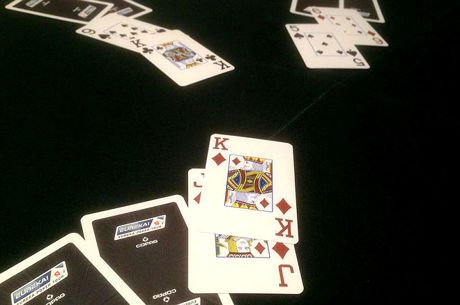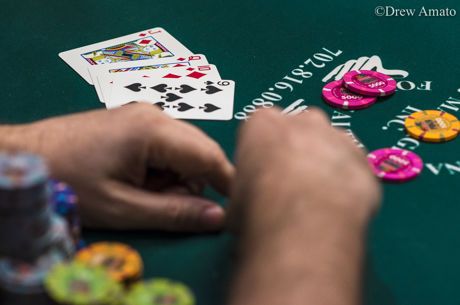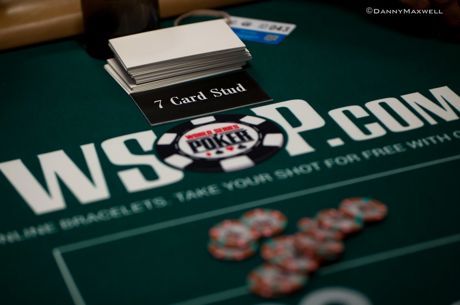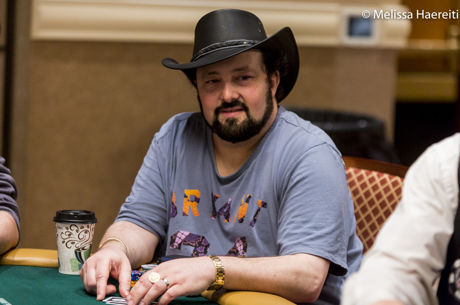Stud Poker Strategy: Multi-handed Pots, Part 1

I've recently read through my stud-poker literature. There isn't a whole lot out there. What there is focuses almost exclusively on heads-up situations. At the higher levels of stud, that's typically what good players face. They're aggressive, and they're relatively tight, so when they're in a hand they're usually leading with it — and chasing out others with bets and raises.
And here's a secret. It's easier to devise a winning strategy when there is only one opponent. It's easier to show what the possible outcomes are when the matches are heads up rather than multi-way. It's even easier to represent hands when there are only two sets of cards to display.
No wonder there isn't more written about multi-way hands.
But here's another interesting observation. In spite of our best intentions, hands are often multi-way — not just at the low-limit games with a lot of calling stations — but at higher limit games like $10/20 and $20/40. In fact, on those rare occasions when I've jumped into the rich $75/150 game, I've found that many of those hands were also multi-way — if not all the way until the river, at least until fifth street. Therefore, it surely helps to know how to address the many situations that present themselves when you have more than one opponent.
I'm not going to write another entire book here on PokerNews — though I suppose if there were sufficient interest in stud there could be an entire book devoted to multi-way situations in stud. Maybe when no-limit hold'em loses its lustre a publisher will approach me for it. But until then, you'll all have to accept a few articles on this topic.
I'm going to divide my comments in the following ways. First I'll address general considerations for playing in hands that tend to be multi-way; then I'll focus on fifth-street decisions; then I'll cover special plays to consider in a multi-way pots. Finally, I'll summarize each of the three general topics. When I'm done I hope to have three or four columns on this subject. And, as always, I'm interested in your feedback. If I get any questions (address them to me at [email protected]) I'll do a column or two answering them.
More competition generally means larger pots than heads-up competition. Some of this is obvious. If five people see fourth street, instead of two, then there are at least five small bets versus at least two small bets in the pot (plus all of the antes). Similarly, if four people are in all the way until the river, the final pot is going to be larger, nearly all the time, than if two people are in all the way to the river. There are exceptions, of course. There could be four players who check it down all the way to the river as opposed to heads-up matches where the bets are raised and re-raised. But most of the time, the more people, the more money.
Because of the larger size of the eventual pot that will be awarded, players are usually getting much greater implied odds on their calls. "Implied odds", you may recall, is a term used to explain the ratio of the bet you must call to stay in the hand on an early street compared with the size of the pot you will eventually win if you win the hand. So, for example, if you are playing a $10/20 limit stud game, if you are facing a $10 bet on third street and expect to win a $1,000 pot if you win the hand then you are getting 100:1 implied odds on your call. (There is a somewhat more complicated method of figuring out implied odds that I am not addressing here. That involves estimating both the eventual size pot you will eventually win if you win compared to the amount of money you estimate you'll have to invest in the hand to see the river.) And so, if you are playing a hand of poker that is likely to have five players calling you down until the river, the pot and thereby the implied odds will be much greater than if you're playing heads up.
Because of the relatively larger implied odds that you get for a call on third street when the pot is likely to be multi-way, you can call much more frequently than you would if the pot you were fighting for would be smaller — as it would be in a heads-up hand. Accordingly, you could play some hands with less likelihood of becoming the winning hand, since you would only to need a few of these larger pots to make money. While you would need to win nearly half of the pots you contested heads up, if the hand had four-way action until the river, and was thus twice as large, you'd only need to win one fourth of those pots to make money.
This doesn't mean that you can play every hand, of course. Some hands will lose money for you no matter how many opponents you have. This is especially true when the cards you need to complete your hand are already out. For example, even if all eight players are likely to be in the hand until the river, if you start with three low clubs and all five of your opponents are showing clubs on third street — meaning you have to catch two of the three that remain in the next four cards — your hand is pretty much valueless. Similarly, if you have a low pair and both your kicker and your pair are dead, your hand is generally worthless, even with many opponents.
Similarly, some hands that may have a small edge in a heads-up contest are unfavored to win the pot if there are many players seeing the river. Consider a medium pair on third street. If you are heads up against a random hand you are likely to be ahead. If you continue heads up to the river you are likely to win the hand, even if your opponent holds over cards that are unpaired. You're not favored by much, but you are slightly favored. On the other hand, if you are against five players, with your medium pair, one or two opponents might have overcards to you and others might be drawing for straights or flushes, and you are surely not favored to win the hand against the field. In fact, depending on the exact holdings of the players, you are likely to be second best in the field of five — with only about a 20% chance of winning the pot.
I've developed some general rules of thumb that allow me to expand my general repetoire of playable third-street hands when the hand is likely to be multi-way. But before I get to it, we need to understand one of the important complexities of multi-way action.
All multi-way games are not created equal. In my next column I'll write about the difference between passive, typically low-limit multi-way stud games and how they differ from aggressive, typically higher-stakes stud games.
Here are some rules of thumb that you can apply to a game that you expect will have at least one extra player tagging along for the all of the action until the river.
Be more willing to call the bring-in bet or a completion with many hands that you wouldn't normally play heads up. Include, for example, cards with even one live ace or a live ace and king. One-gapped three-straights, even low ones, are fine to play if the cards needed to make them — especially the "middle" card — are live. Small pairs are playable even with low kickers or dead kickers — since if you make your trips you'll be likely to make more than in games that tend to be heads up.
Be willing to play these sub-standard starting hands for two bets if you know that you will end the action with a call and if the hand is four-way (including you) or larger. Don't be too quick to dispose of these hands on fourth street, either, just because they didn't improve. If, for example, your low three-flush didn't improve on fourth, you can surely stay in until fifth sreet if the betting is light. Similarly, you can call a single bet on fourth with your low pair and with three big cards, presuming no one else seems to have improved.









